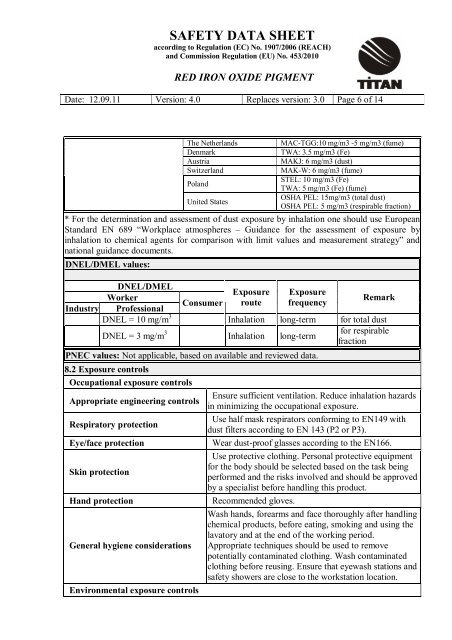SAFETY DATA SHEET - Crimea Titan PJSC
SAFETY DATA SHEET - Crimea Titan PJSC
SAFETY DATA SHEET - Crimea Titan PJSC
Create successful ePaper yourself
Turn your PDF publications into a flip-book with our unique Google optimized e-Paper software.
<strong>SAFETY</strong> <strong>DATA</strong> <strong>SHEET</strong><br />
according to Regulation (EC) No. 1907/2006 (REACH)<br />
and Commission Regulation (EU) No. 453/2010<br />
RED IRON OXIDE PIGMENT<br />
Date: 12.09.11 Version: 4.0 Replaces version: 3.0 Page 6 of 14<br />
The Netherlands MAC-TGG:10 mg/m3 -5 mg/m3 (fume)<br />
Denmark TWA: 3.5 mg/m3 (Fe)<br />
Austria MAKJ: 6 mg/m3 (dust)<br />
Switzerland MAK-W: 6 mg/m3 (fume)<br />
Poland<br />
STEL: 10 mg/m3 (Fe)<br />
United States<br />
TWA: 5 mg/m3 (Fe) (fume)<br />
OSHA PEL: 15mg/m3 (total dust)<br />
OSHA PEL: 5 mg/m3 (respirable fraction)<br />
* For the determination and assessment of dust exposure by inhalation one should use European<br />
Standard EN 689 “Workplace atmospheres – Guidance for the assessment of exposure by<br />
inhalation to chemical agents for comparison with limit values and measurement strategy” and<br />
national guidance documents.<br />
DNEL/DMEL values:<br />
DNEL/DMEL<br />
Worker<br />
Industry Professional<br />
Consumer<br />
Exposure<br />
route<br />
Exposure<br />
frequency<br />
Remark<br />
DNEL = 10 mg/m 3 Inhalation long-term for total dust<br />
DNEL = 3 mg/m 3 Inhalation long-term<br />
PNEC values: Not applicable, based on available and reviewed data.<br />
for respirable<br />
fraction<br />
8.2 Exposure controls<br />
Occupational exposure controls<br />
Ensure sufficient ventilation. Reduce inhalation hazards<br />
Appropriate engineering controls<br />
in minimizing the occupational exposure.<br />
Use half mask respirators conforming to EN149 with<br />
Respiratory protection<br />
dust filters according to EN 143 (P2 or P3).<br />
Eye/face protection Wear dust-proof glasses according to the EN166.<br />
Use protective clothing. Personal protective equipment<br />
for the body should be selected based on the task being<br />
Skin protection<br />
performed and the risks involved and should be approved<br />
by a specialist before handling this product.<br />
Hand protection Recommended gloves.<br />
General hygiene considerations<br />
Environmental exposure controls<br />
Wash hands, forearms and face thoroughly after handling<br />
chemical products, before eating, smoking and using the<br />
lavatory and at the end of the working period.<br />
Appropriate techniques should be used to remove<br />
potentially contaminated clothing. Wash contaminated<br />
clothing before reusing. Ensure that eyewash stations and<br />
safety showers are close to the workstation location.



